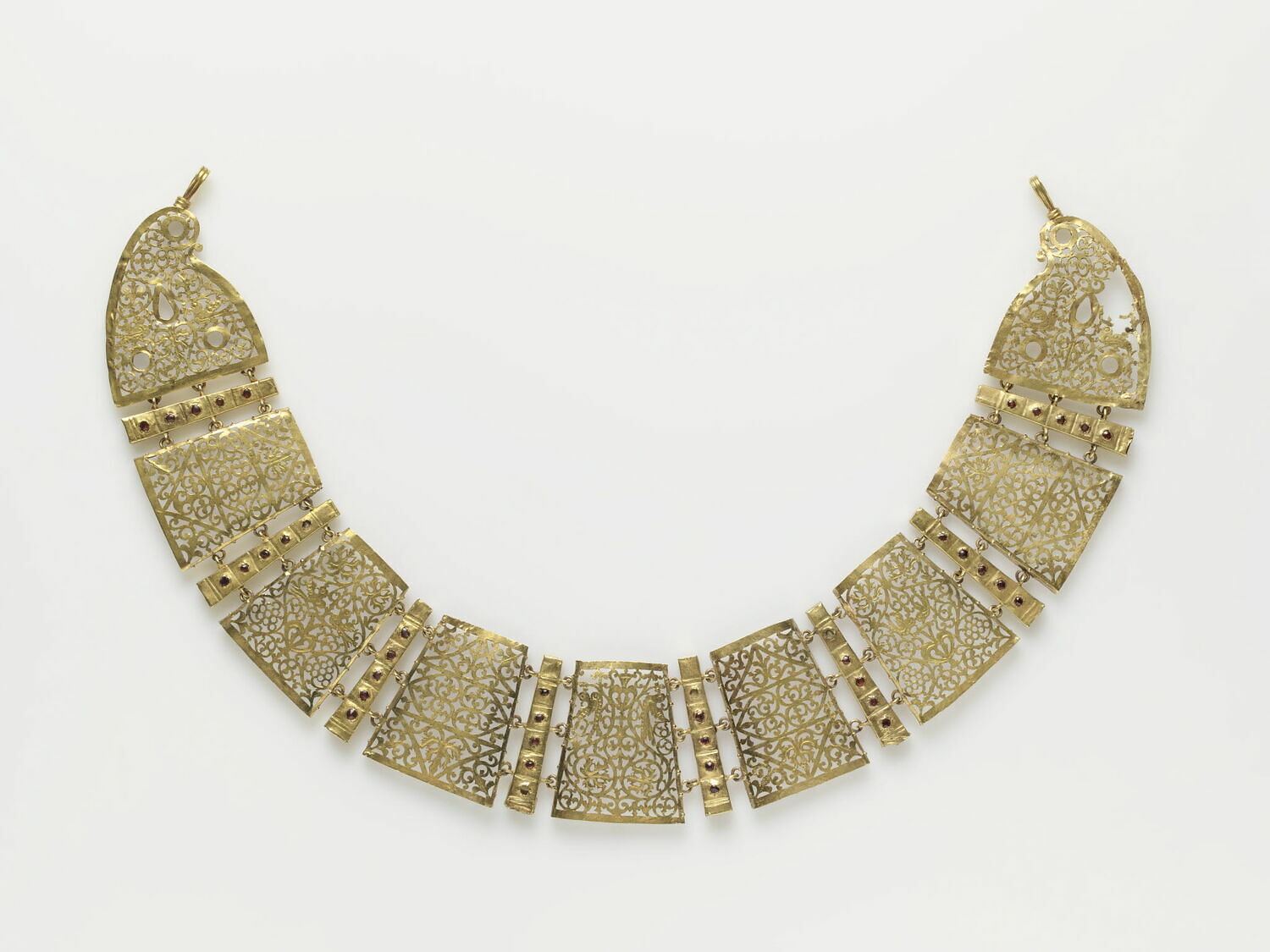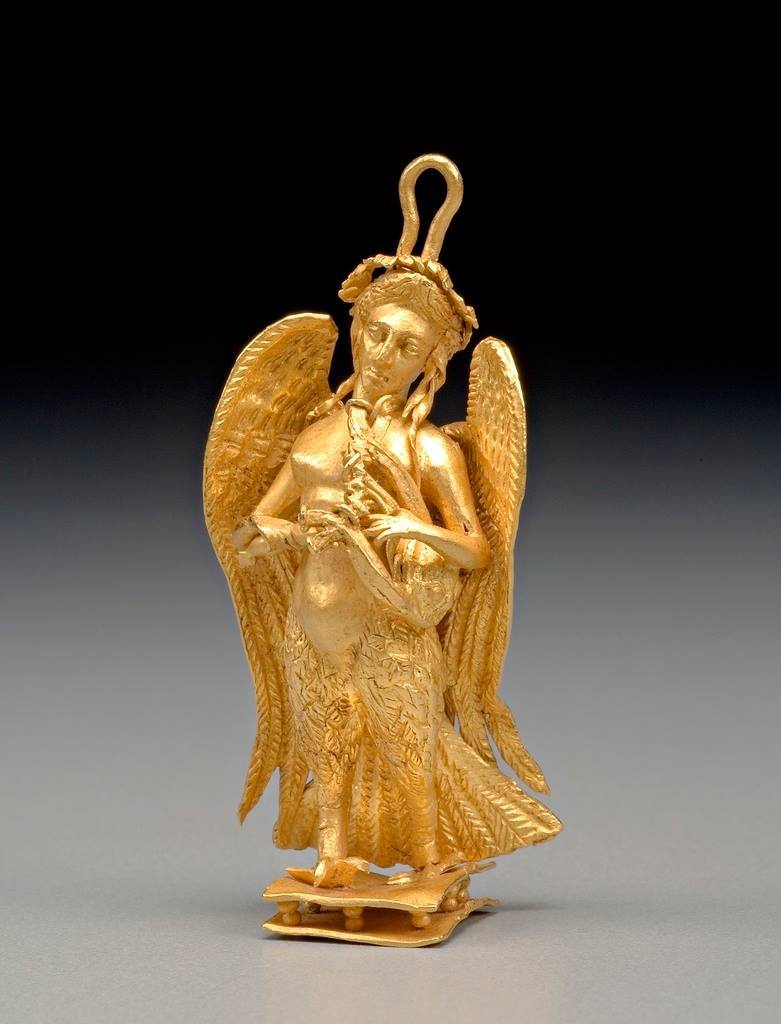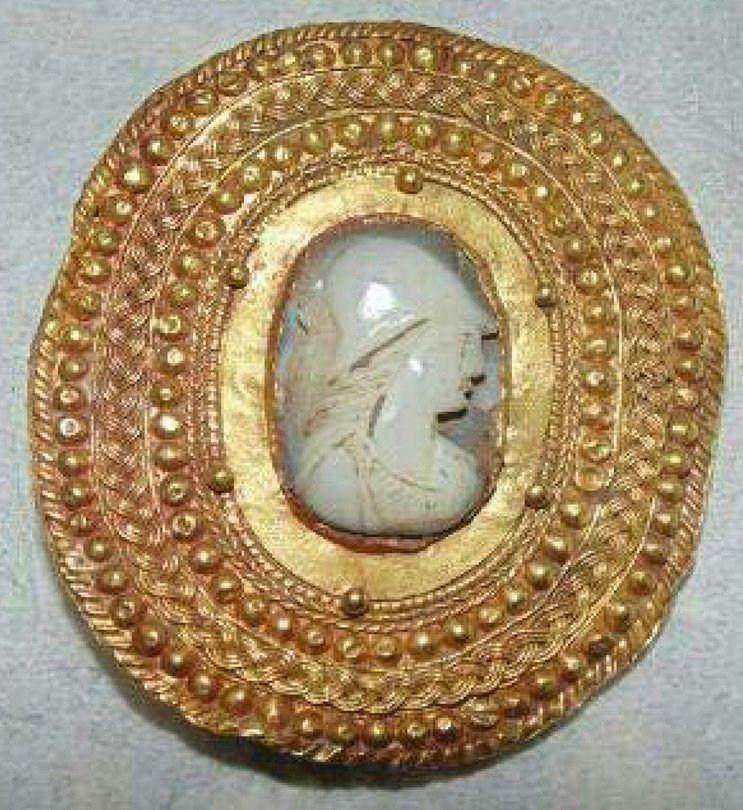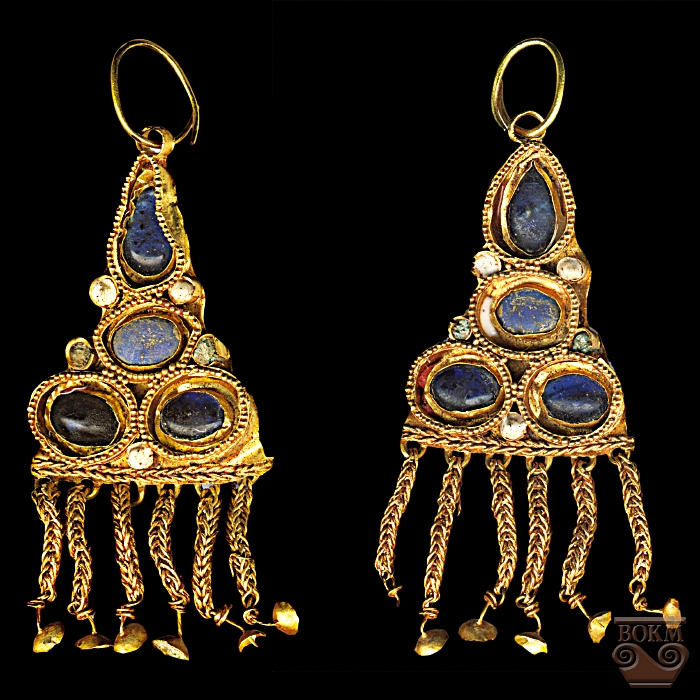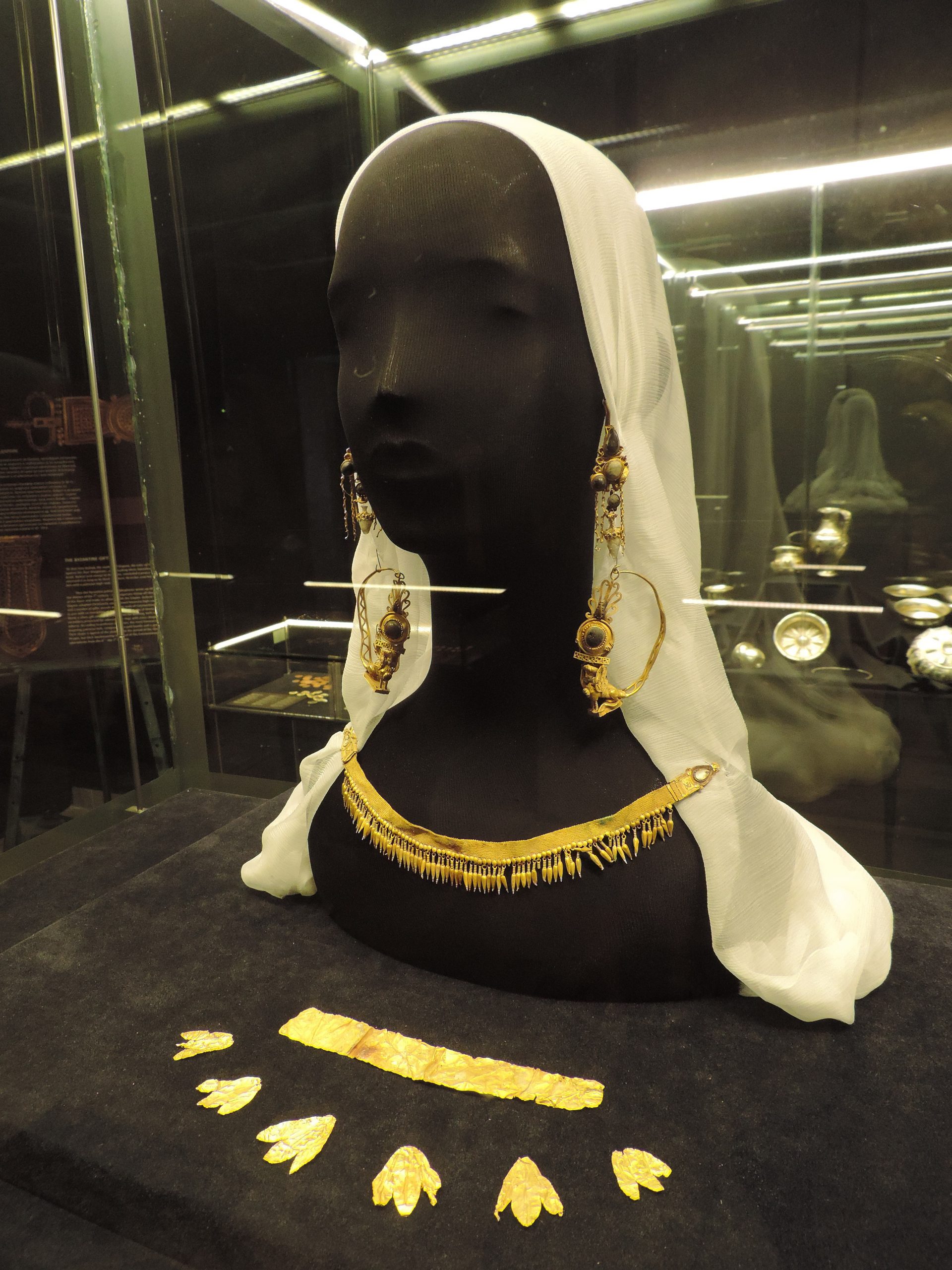



“Greco-Roman Jewellery from the Necropolis of Qasrawet (Sinai)”
Renate Rosenthal-Heginbottom
Qasrawet — Tomb 2
Tomb 2 had already been looted in antiquity. It was a stone-built tomb, a sort of sarcophagus without bottom, covered by slabs [Rosenthal-Heginbottom, R. 2015, Grave goods]
Single earring: baretta type; 1st-2nd century
Height 3.5 cm, width 1.9 cm.
“The earring consists of a blue glass paste bead set in a bezel and an immovable nearly square pendant, their ratio in height being 1 : 3. The pendant has four units. At the top a broad piece of gold foil is soldered onto the lower edge of the bezel, the joint concealed by five tiny globules. It is decorated with wire and globule clusters: a row of globules between two spiral-spool wires and in each upper corner a rosette of five dots. The middle part is filigree work without a background support, a kind of openwork lattice of four double spirals with granule clusters, possibly two flowers. The lower section is made of a double spiral-spool wire to which three globules adorned with globule clusters are attached. The rear side is less elaborate. A large hoop of round wire is attached which is hammered flat and soldered on the bezel. Its hooked end is inserted into a small ring on the central globule of the bottom row.
A singular creation, the closest parallels are a single earring from a late Hellenistic – early Roman tomb at Kaimakli (Nicosia) in Cyprus, another singleton and a pair, both of unknown provenience and dated to the 1st and 2nd centuries CE. The technical aspects suggest that the goldsmith of the Qasrawet piece was not particularly skilled. Considering the elements of composition the earring can be attributed to the baretta type composed of three elements: a disc, a bar, and pendants, a type beginning in the 1st century CE and continuing into the 4th. On Egyptian mummy portraits women are depicted with the baretta type characterised by three movable pendants decorated with beads. The type is quite varied.
There are differences in the proportions of disc and bar as well as in the number of the mostly movable pendants. A Syro-Roman type in openwork technique is dated by burials to the 3rd century CE. However the different proportions of the three elements of composition and the use of wire, filigree, and granule clusters suggest an earlier 1st–2nd century date for the earring from Qasrawet.”


“Greco-Roman Jewellery from the Necropolis of Qasrawet (Sinai)”
Renate Rosenthal-Heginbottom
Single earring: shield with immovable pendant
Height 4.8 cm, width 1.9 cm.
1st century BCE into the 2nd century CE

“The earring is made of a convex shield soldered onto a flat frame and an immovable pendant in the shape of a cluster of grapes. In the centre of the shield a red stone is set in a bezel from which granulated rays with three tiny globules at each end emerge – originally six with one missing. They form a star-shaped rosette. The outer edge is decorated in filigree: stringed globules or beaded wire framed on each side by spiral-spool wire like a braided border.
A pendant in shape of a large cluster of grapes is soldered to the lower edge the shield. It is formed by granule clusters in three sizes: at the top a double row of medium sized ones, followed by five larger ones in two rows and an additional bi-conical globule with rows of small globules holding larger ones together. The damaged bottom globule displays a central vertical flat wire by which the cluster of grapes appears to be held together and which also runs along the back side of the shield, ending in a ring projecting above the upper edge of the shield. The transition from the ring to the shield is disguised by two clusters of three tiny globules. The hoop is formed of twisted wire hooked at the top into the ring of the shield and at the bottom into another small ring soldered onto the back of the pendant.
The earring is singular. The plasticity of the grapes is obvious, yet at the same time it is not naturalistic, but disproportionate and bulky. Compare for example the naturalistic rendering of a Hellenistic earring with a shield and an immovable pendant in the shape of carnelian grapes and gold leaf and tendril scroll. Stylistically close to the Qasrawet find are Syrian earrings with elaborate immovable clusters forming an inverted pyramid. A more schematic cluster of grapes, made of nine rows of medium sized globules with a larger at the bottom, forms the immovable pendant of a single earring from Egypt, now in the collection of the University of Trier. Dated to late imperial times the upper section of the earring is formed by a flat oval wreath instead of the shield, yet the height of 4.5 cm corresponds to the Qarawet earring.
The combination of shield and immovable pendant recalls the rather uniform class of Syro-Roman earrings with double spirals on an oval shield and a heavy immovable pendant of globules of different sizes resembling an inverted pyramid. With a height of 6 cm they are relatively large. They are dated to the 2nd – 3rd centuries CE and occur as burial finds over a wide area of distribution in the modern states of Syria, Lebanon, Israel and Jordan. A rosette surrounded by star-shaped granulation is found on the shield of another pair of this type.
For the Qasrawet earring a date from the 1st century BCE into the 2nd century CE could be considered on typological considerations.”
Mampsis: jewelry from the Tomb 119, a female burial with two pairs of earrings and a nose-ring
Grave Goods and Nabatean Identity: Mampsis and Qasrawet, Rosenthal-Heginbottom, Renate

photo: Roy Brodi

Tomb 119

(photo: Susi Abelin)

(photo: Susi Abelin)
Pair of crescent-shaped earrings with granulation and in openwork technique.
Left earring: height and width 3 cm., weight 2 g.; right earring: height 2.7 cm., width 2.9 cm., weight 1.8 g. The pair is not identical.
“Each earring is composed of two crescents cut out of sheet gold and soldered together. The upper and narrower one is decorated with fifteen small umbos, each of which is decorated with seventeen minute grains. The lower and wider crescent is decorated with triangles and bars on which minute grains are applied”
Nose-ring with granulation
(Height 2.4 cm., width 1.7 cm., weight 0.78 gm.)
“The use as nose-ring is confirmed by its location within the skull in the burial at Mampsis, by the fact that such objects occur in single pieces and that the pendant is firmly soldered onto the loop and thus immovable”

(photo Susi Abelin)
Pair of boat-shaped earrings with semiprecious stones
(Left earring: height 1.4 cm., width 1.8 cm., weight
1.23 gm.; right earring: height 1.5 cm., width 1.8
cm., weight 0.5 gm.)
“The navicella-type earrings were made by beating sheet gold over a core made of past. The core was probably used to strengthen the object since it was made of very thin gold (the earring on the right is hollow and slightly damaged). Both earrings are decorated with a bezel-set semi-precious stone of reddish-white color. There is a vertical nick at the bottom. The tube ends in a very thin wire, and both ends form a sling slot. This type of closure made removal difficult so that they were probably permanently worn.
Their size points to a child, underlining the interpretation that Nabatean women owned two pairs, one given when young and the other upon marriage.
Mampsis — Tomb 100
Grave Goods and Nabatean Identity: Mampsis and Qasrawet, Rosenthal-Heginbottom, Renate
Tomb 100 in Mampsis – a female burial with a single elaborate earring (the second probably lost during the life-time of the interred individual), a pair of simple earrings, a dolphin-shaped pendant and a denarius of Trajan.

and a denarius of Trajan (photo: Roy Brodi)

https://www.imj.org.il/en/collections/397875
Mampsis — Tomb 100
Roman period, first half of the 1st century CE
Museum description:
The bronze statuette presents the goddess Aphrodite arranging her hair, her garment hugging her figure from the waist downwards. The earring contains a miniature shrine at its center, in which is found the figure of Aphrodite wringing her hair as she rises from the foam of the sea.

https://www.imj.org.il/en/collections/397877
Mampsis — Tomb 112
Roman period, 1st – mid-2nd century CE
Museum description:
“earrings are decorated with two eyes and a nose, representing the Nabatean goddess al-Uzza, the equivalent of Venus, the Roman goddess of love and beauty.”

Single disc-shaped earring with Aphrodite
(Height 2.5 cm., width 1.7 cm., weight 1.38 gm.)
“The earring is decorated with Aphrodite Anadyomene standing in a shrine and flanked by two garnets set in a bezel (Patrich 1984: Fig. 3:3; 1990: Fig. 46b; Rosenthal-Heginbottom 2003: Fig. 59.1). The figure of the goddess was cut out of sheet gold and her features were reproduced in repoussé technique. The surface has nine clusters of granulated grains and the edge is surrounded by a plaited wreath with six clusters of granulation grains hanging from it.
The excellent workmanship has a parallel in a
pair of disc-shaped earrings from Tomb 112.”
Earrings from Mampsis, Tomb 112.
“Surrounded by a wreath, the disc is decorated by two
vertically bezel-set garnets and a small shield set in the center below the garnets. J. Patrich has identified the combination of stones and shield as an eye idol (betyl), representing two eyes and nose and concludes that the goddess Aphrodite / al-Uzza can be depicted in an anthropomorphic and aniconic manner (Patrich 1984; Zayadine 1984). The equation of Aphrodite and al-ʽUzza is confirmed by a bilingual Nabatean-Greek dedicatory inscription discovered on the island of Kos. Even though the equation seems plausible, caution should be exercised. On the numerous Nabatean betyls, the eyes are never set vertically but are generally almond-shaped, set horizontally; furthermore, inscriptions indicate that betyls are not restricted to al-ʽUzza The earring type, the disc with a single side
decorated like the crescent-shaped earrings, has so far not been recorded from other excavations; few parallels exist in collections. With regard to stylistic elements, a pair of earrings said to be from Syria is the closest parallel. The discs are crescent-shaped and decorated on both sides with a central stone (all four are missing), three bezel-set stones on the surface and a garnet in each corner of the crescent. Clusters of granulation are spread on the surface. Related are a single piece, possibly an earring, with two lateral garnets and a central umbo with clusters of granulation and three small disc-shaped medallions for necklaces.”
[Rosenthal-Heginbottom, Grave goods]
“Many tombs have suffered from plundering in both ancient and modern times and therefore the material remains do not permit definite conclusions. Gold and jewels are mentioned in a fragmentary, early 2nd century CE inscription from Tomb 64 A, opposite the Khazneh at Petra, in which a female was buried.
The evidence from the undisturbed graveyard of Mampsis shows that several women were buried with two pairs of earrings: one pair of hoop or boat-shaped navicella-type earrings and a second more elaborate pair.
Possibly one pair of earrings was given to the woman when she was a child or adolescent and the more elaborate ones when she was older, perhaps upon her marriage. A burial in Jerusalem contained the body of a young woman aged 20–25 years who was laid to rest with two pairs of earrings: a simple and an elaborate one. It is dated to the early 3rd century and might belong to the families of Roman military units stationed there. […]
The probable Nabatean origin of items in the possession of museums and private collectors can only be determined through stylistic comparison. Admittedly without written evidence Nabatean jewelry should be defined as objects created in the region under Nabatean control for the use of the local population.[…]
the variegated items of gold jewelry retrieved in Nabatean contexts of the first and second centuries Ce are inspired by Graeco-Roman prototypes in the Levant, particularly in Syria and Egypt. While most pieces are not of the quality of fine workmanship produced in these centers, iconographic and stylistic details define them as singular innovative products, created by local artisans.
For the owners, jewelry was a status symbol indicating prosperity. The Nabateans acquired an immense wealth based on the revenue from the incense and spice trade. Despite their extensive trade connections, no foreign jewelry was imported, nor were Nabatean types exported. These facts underscore the likelihood of the existence of Nabatean goldsmiths. The question of centralized or decentralized production cannot be answered, though Petra should be considered a primary candidate, recalling that Strabo speaks of Nabatean gold and silver production.” [Grave Goods and Nabatean Identity: Mampsis and Qasrawet, Rosenthal-Heginbottom, R]
- Rosenthal-Heginbottom, R. (2020). Greco-Roman Jewellery from the Necropolis of Qasrawet (Sinai). Journal of Hellenistic Pottery and Material Culture, 1(`), 169–191. Retrieved from https://archaeopresspublishing.com/ojs/index.php/jhp/article/view/836
- Grave Goods and Nabatean Identity: Mampsis and Qasrawet, Rosenthal-Heginbottom, R. 2015 https://www.academia.edu/10226193/Grave_Goods_and_Nabatean_Identity_Mampsis_and_Qasrawet



